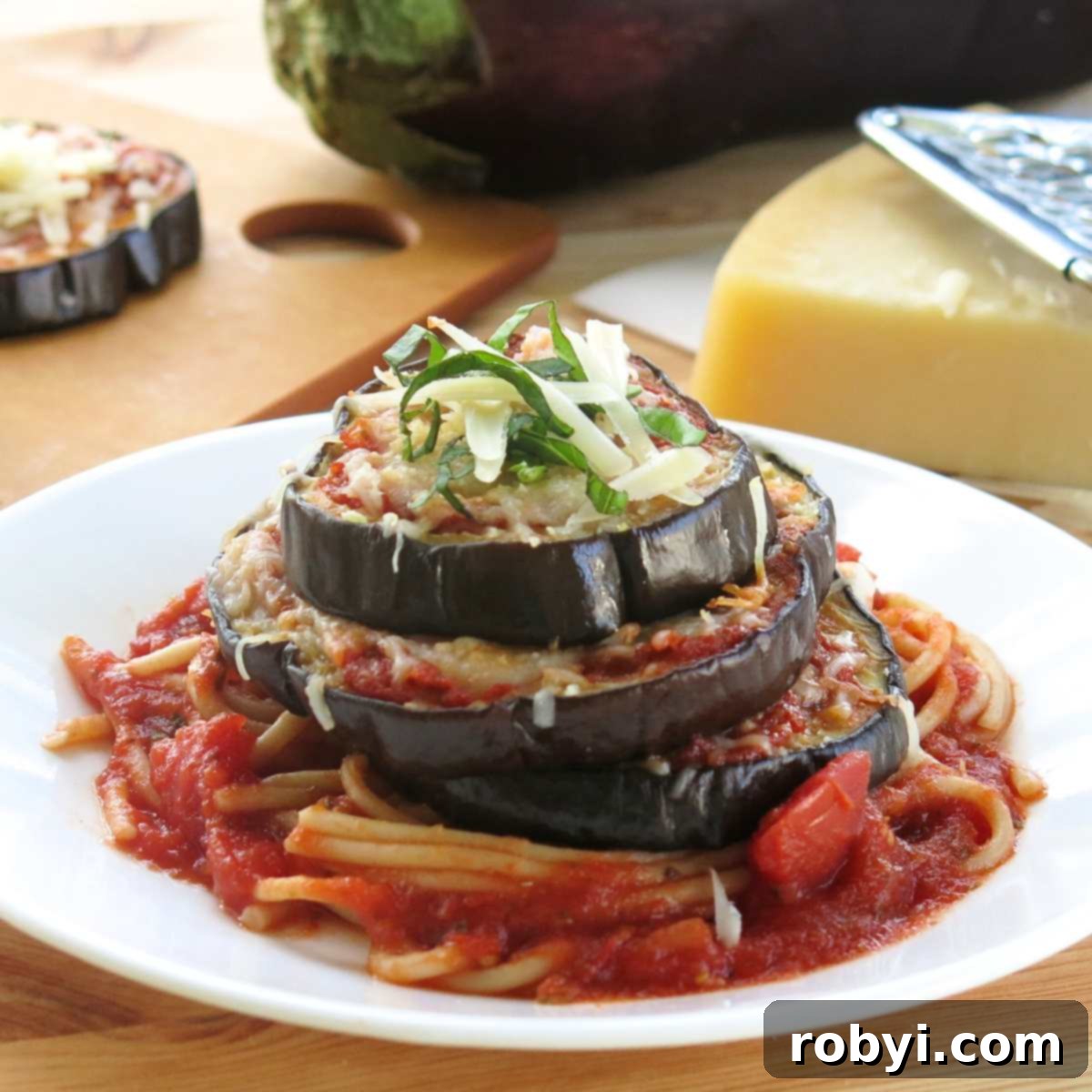Delightful No-Breading Eggplant Parmesan Stacks: Your Healthy, Low-Carb Italian Favorite
Craving a classic Italian dish without the carb overload? Our Eggplant Parmesan Stacks are the answer! Expertly crafted without breadcrumbs, these individual towers are naturally low-carb, keto-friendly, and gluten-free. Forget the messy frying; these festive, oven-baked delights are incredibly easy to make and destined to become a cherished family favorite. Prepare for a melt-in-your-mouth experience that satisfies your Italian cravings in the healthiest way possible.
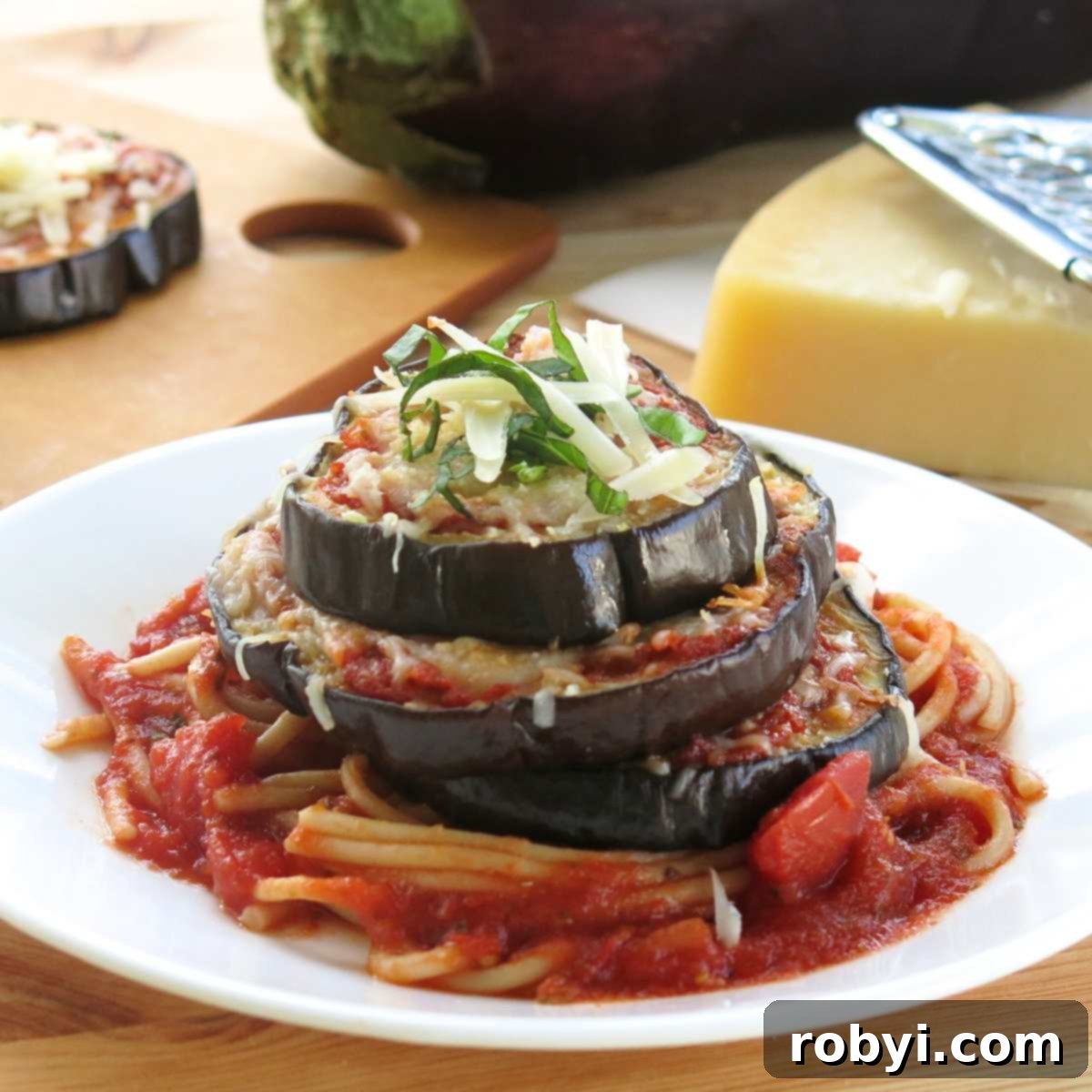
It might seem too simple to share, but this stacked eggplant parmesan recipe has earned its permanent spot in my regular summer dinner rotation. Its delightful flavor profile is so impressive that it’s sure to become your new favorite Italian-inspired dish, too!
While the accompanying photo features these savory stacks served over traditional pasta, that’s usually reserved for the rest of the family. For my personal enjoyment and to keep this recipe strictly keto-friendly, I often pair my eggplant stacks with fresh zoodles (zucchini noodles). This simple swap transforms the dish into a complete and satisfying meal that aligns perfectly with a low-carb lifestyle.
To be completely honest, I’m the primary eggplant enthusiast in my household. So, on spaghetti night, this delightful dish is crafted specifically for ME! Meanwhile, everyone else happily enjoys delicious Baked Chicken Parmesan Meatballs, a dish that cleverly shares many of the same wholesome ingredients, ensuring everyone has a meal they love.
And the best part? The joy of having leftovers! They’re not just for reheating; they transform into an incredible Eggplant Parmesan Dip the next day, offering a delicious second life to this versatile dish.
Why These No-Breading Eggplant Parmesan Stacks Will Be Your New Go-To Recipe
Our Eggplant Parmesan Stacks are more than just a meal; they’re a revelation in healthy Italian cooking. Here’s why this recipe deserves a prime spot in your culinary collection:
- Minimal Ingredients, Maximum Flavor: You only need five simple ingredients to create this culinary masterpiece, and notably, breadcrumbs and eggs are completely absent. This streamlined approach means less shopping and less fuss in the kitchen.
- Effortless Oven-Baked Perfection: Say goodbye to oily, fried eggplant. Our recipe involves roasting the eggplant in the oven until perfectly tender, then baking it with cheese until it’s gloriously melty and bubbly. This method is not only healthier but also significantly reduces cleanup.
- Wholesome and Dietary-Friendly: This recipe is a health champion! It’s inherently low-carb, keto-approved, and naturally gluten-free. For our vegetarian friends, simply opt for a Parmesan cheese made with vegetable rennet (we have a suggestion below!) to keep it entirely plant-based.
- Irresistibly Delicious: Prepare for a dish that truly melts in your mouth. The combination of tender eggplant, rich sauce, and savory cheeses creates an unforgettable flavor experience that will have you coming back for more.
- Elegant Presentation: Beyond its incredible taste, the stacked tower presentation adds a touch of whimsy and sophistication to any meal. It’s a dish that impresses both the palate and the eye, making it perfect for entertaining or simply elevating a weeknight dinner.
Essential Ingredients for Perfect Eggplant Parmesan Stacks
Crafting these delectable Eggplant Parmesan Stacks requires a handful of high-quality, fresh ingredients. Here’s a detailed look at what you’ll need to ensure culinary success:
- Eggplant: The star of our show! We recommend using smaller American or globe eggplant varieties for the best results. These tend to have fewer seeds and a sweeter, more tender flesh after cooking. For more guidance, be sure to check our dedicated section below on how to select the finest eggplant.
- Pasta Sauce: The foundation of flavor for your stacks. While any quality tomato sauce or marinara will work beautifully, for those following a keto or low-carb diet, it’s crucial to select a brand that is low in sugar. Always check the nutrition label to ensure it aligns with your dietary goals.
- Mozzarella Cheese: This provides that quintessential gooey, melty texture. Opt for freshly shredded mozzarella for superior melting and flavor compared to pre-shredded varieties, which often contain anti-caking agents that can affect texture.
- Parmesan Cheese: Adds a sharp, salty depth of flavor that complements the sweet eggplant.
- A Note for Vegetarians: Traditional Parmesan cheese is often made with animal rennet, rendering it non-vegetarian. If you’re looking to keep this dish plant-based, seek out a vegetarian-friendly brand like BelGioioso Vegetarian Parmesan, which uses microbial rennet.
- Fresh Basil: The vibrant, aromatic finish. Fresh basil, cut into delicate strips (chiffonade), elevates the dish with its bright, peppery notes. It should be added just before serving to preserve its freshness. If fresh basil is unavailable, you can substitute with dried basil, but remember to add it earlier in the cooking process, alongside the sauce and other cheeses, to allow its flavor to meld.
- Olive Oil & Salt: These essential pantry staples are used during the initial roasting phase of the eggplant, enhancing its flavor and ensuring it cooks to perfection before the sauce and cheese are introduced.
Keep in mind that the precise quantity of sauce and cheese you apply to each eggplant round can vary significantly depending on the size of your eggplant slices. We encourage you to refer to the accompanying images in this post to get a visual idea of how much we recommend for each slice. Personally, I prefer a minimalist approach when it comes to the sauce, allowing the natural flavors of the eggplant to shine through!
For the exact suggested ingredient amounts and step-by-step cooking instructions, please refer to the comprehensive recipe card located at the bottom of this page.
Mastering Eggplant Selection: Tips for Choosing the Best Globe Eggplant
After years of selecting globe eggplants at the grocery store, and occasionally letting them linger too long before enjoying them, I’ve gathered some invaluable insights. Choosing the right eggplant is key to a delicious and tender dish. Here’s what you need to know:
- Opt for Smaller Eggplants: When it comes to eggplant, size often matters. Smaller eggplants are generally easier to handle, contain fewer seeds, and boast a naturally sweeter flavor. Their skin also tends to be more tender after cooking, eliminating the need for peeling in many cases.
- Examine the Skin and Stem: A healthy eggplant will have smooth, shiny skin without any blemishes, wrinkles, or soft spots. The skin should appear vibrant and taut, indicating freshness. Also, pay attention to the stem; it should be green and fresh-looking, not brown or dried out.
- Perform the “Bounce-Back” Test: Gently press your finger into the eggplant’s skin. A fresh, ripe eggplant should feel firm but yield slightly to the pressure, then bounce right back to its original shape. If it feels hard and unyielding, it’s likely underripe. If it feels mushy or leaves a lasting indentation, it’s past its prime.
- Inspect the Flesh (If Possible): While not always feasible in a grocery store, if you can glimpse the interior (e.g., if there’s a cut side), the flesh should be mostly white. Small brown spots around the seeds are normal, but widespread discoloration or excessive browning suggests an older eggplant.
- Consider Weight: A good eggplant should feel relatively heavy for its size. This indicates a good water content, which translates to juicy, flavorful flesh.
By following these simple tips, you’ll consistently pick perfect eggplants, ensuring your dishes are always at their best.
Step-by-Step Guide: Crafting Your Easy Eggplant Parmesan Stacks
Creating these simple yet elegant eggplant parmesan stacks is a straightforward process. Follow these detailed steps for a perfectly baked, no-breading delight:
- Prepare the Eggplant: Begin by preheating your oven to 400°F (200°C). Wash and thoroughly dry your eggplants. Using a sharp knife, slice each eggplant into rounds approximately ⅜ of an inch thick. Consistency in thickness is crucial for even cooking; slices that are too thin may burn, while those too thick will require longer baking times. Once sliced, gently blot any excess moisture from both sides of the eggplant rounds with paper towels. (Refer to our section below on “To Sweat or Not To Sweat” for more details on moisture removal.)
- First Roast: Arrange the eggplant slices in a single layer on a baking sheet that has been lightly coated with cooking spray or lined with parchment paper. Brush the top side of each slice generously with olive oil and sprinkle with a pinch of salt. Roast in the preheated oven for 10-12 minutes, or until the eggplant begins to soften and lightly brown.
- Second Roast & Flip: Carefully remove the baking sheet from the oven. Using tongs or a spatula, flip each eggplant slice. Brush the newly exposed side with olive oil and sprinkle with salt. Return the pan to the oven and roast for another 10-12 minutes, or until both sides are tender and slightly golden.
- Prepare for Layering: Once the eggplant slices are cooked, remove the baking sheet from the oven. Reduce your oven temperature to 350°F (175°C). This lower temperature is ideal for melting the cheese without overcooking the eggplant.
- Layer the Flavors: On each roasted eggplant slice, spread a thin, even layer of your chosen pasta sauce. Follow this with a generous sprinkling of shredded mozzarella cheese and then a lighter dusting of grated Parmesan cheese. Don’t overload the slices; a balanced amount ensures proper melting and prevents sogginess.
- Final Bake: Return the baking sheet to the oven and bake for an additional 15-20 minutes. Keep a close eye on them; the goal is for the cheeses to be completely melted, bubbly, and just beginning to turn a beautiful golden brown.
- Assemble Your Stacks: Allow the baked eggplant slices to cool for a few minutes on the baking sheet. This brief cooling period makes them easier to handle and prevents them from falling apart when stacked. Carefully stack 2 or 3 eggplant slices on top of each other, starting with the largest slice at the bottom for stability, creating elegant individual towers.
- Garnish and Serve: Garnish your beautiful Eggplant Parmesan Stacks with fresh basil strips and an extra sprinkle of Parmesan cheese, if desired. Serve immediately and enjoy your healthy, homemade Italian masterpiece!
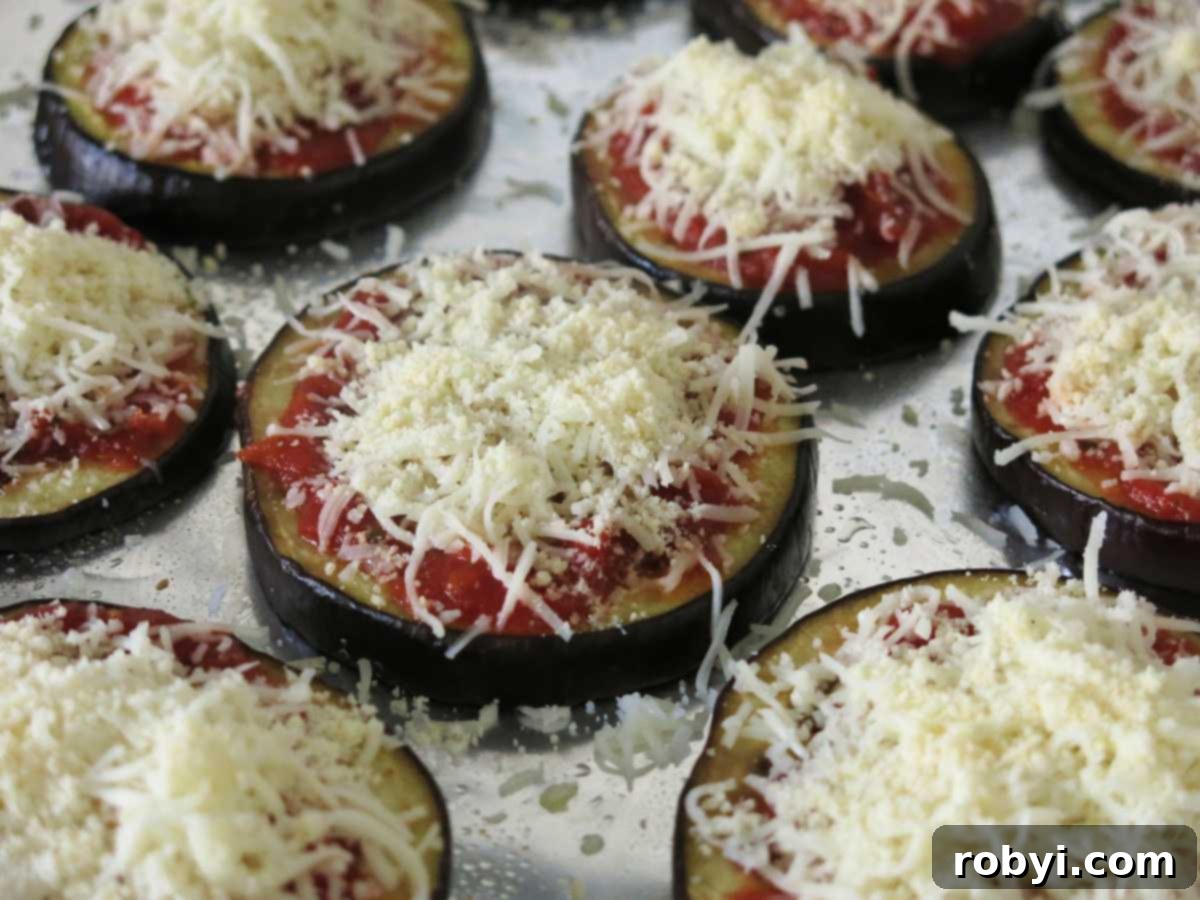
Eggplant Moisture: To Sweat or Not To Sweat?
Ah, the age-old question in eggplant preparation: should you “sweat” your eggplant slices? For years, sweating eggplant was considered a mandatory step to remove bitterness and excess moisture. However, culinary practices evolve, and I’ve personally moved away from this step for this particular recipe.
The “Don’t Sweat It” Philosophy: In modern cooking, particularly with newer eggplant varieties, the necessity of sweating is often debated. Many contemporary chefs, and indeed myself, find this step unnecessary for several reasons:
- Reduced Bitterness in Modern Eggplants: Today’s cultivated eggplants, especially the smaller globe varieties commonly found in stores, have been bred to contain significantly less solanine, the compound responsible for bitterness. As a result, bitterness is rarely an issue anymore.
- Moisture Control Through Roasting: For this specific recipe, where the eggplant is roasted first, the dry heat of the oven naturally draws out moisture without the need for a pre-salting step. Blotting with paper towels after slicing is usually sufficient to manage surface moisture.
- Time-Saving Convenience: Skipping the sweating process saves a considerable amount of time and effort, making this already simple recipe even quicker to prepare. I always gravitate towards smaller eggplants, which undoubtedly contributes to this ease.
When to “Sweat It” (And How): Despite my personal preference for skipping it, there are valid reasons why some cooks still choose to sweat their eggplant, particularly with larger, older, or less common varieties that might retain more bitterness or water:
- Process: If you decide to sweat your eggplant, here’s how: After slicing, arrange the rounds in a single layer on paper towels. Generously sprinkle salt over both sides of the slices. Let them sit for at least 30 minutes, or up to an hour. You’ll observe beads of moisture (the “sweat”) forming on the surface as the salt draws out water and, potentially, bitter compounds.
- Rinsing: Before proceeding with the recipe, it’s crucial to thoroughly rinse the eggplant slices under cold running water to remove all the salt. After rinsing, pat them *very dry* with paper towels. Failure to rinse adequately will result in an overly salty dish, and insufficient drying will negate the purpose of sweating by reintroducing excess moisture.
Ultimately, whether you sweat your eggplant or not is a matter of personal preference, the type of eggplant you’re using, and the desired texture. For these no-breading stacks, I find it perfectly fine to skip, but feel free to experiment to find what works best for you!
Creative Variations: Beyond the Classic Eggplant Stacks
While our Eggplant Parmesan Stacks are a fantastic dish on their own, the beauty of this recipe lies in its versatility. You don’t have to limit yourself to stacking the cooked eggplant rounds; there are numerous ways to enjoy these delicious, no-breading slices:
- Appetizer Bites: For a delightful starter or party snack, simply use smaller eggplant slices. Cook them according to the recipe, but instead of stacking, serve them individually on a platter. They make perfect bite-sized appetizers, ideal for mingling or a light pre-dinner treat. Consider adding a small dollop of pesto or a sprinkle of chili flakes for an extra flavor kick.
- Eggplant “Pizza” Rounds: Transform larger eggplant rounds into personal, low-carb pizzas! After roasting and adding the sauce and cheese, feel free to get creative with your favorite pizza toppings. Think sliced mushrooms, bell peppers, olives, spinach, or even a sprinkle of crumbled sausage (if not strictly vegetarian). Bake until the cheese is melted and bubbly, and the toppings are warmed through. This is a fun and customizable option that appeals to all ages.
- Spice It Up: For those who enjoy a little heat, incorporate red pepper flakes into your pasta sauce or sprinkle them over the cheese before baking.
- Herb Infusion: Experiment with different fresh herbs. Besides basil, a touch of fresh oregano or thyme can add another layer of Italian aroma.
- Different Cheeses: While mozzarella and Parmesan are classic, don’t hesitate to try other melting cheeses. Provolone, fontina, or even a smoked mozzarella could add unique flavor profiles. For a tangier note, a touch of goat cheese or feta can be surprising.
- Add Veggies: Before baking with sauce and cheese, you could lightly sauté thin slices of zucchini, bell peppers, or onions and layer them onto the eggplant rounds for added nutrients and texture.
These variations prove that healthy eating doesn’t have to be boring. Let your culinary imagination run wild and adapt this recipe to your taste and dietary needs!

Perfect Pairings: What to Serve with Eggplant Parmesan Stacks
Whether you’re enjoying eggplant as a traditional baked dish or as these elegant stacked towers, rounding out the meal with complementary side dishes enhances the dining experience. Here are some fantastic suggestions to pair with your no-breading eggplant parmesan:
- Low-Carb Pasta Alternatives: For those adhering to a low-carb or keto diet, traditional pasta might be out, but delicious alternatives abound. Consider serving your eggplant stacks with:
- Zoodles (Zucchini Noodles): A light and fresh option that perfectly soaks up any extra sauce.
- Spaghetti Squash: Offers a slightly firmer texture and a mild sweetness.
- Cauliflower Rice: A versatile and neutral base that won’t overpower the main dish.
- Keto Pasta: Several brands now offer pasta made from konjac or other low-carb flours.
- Crisp Green Salad: A refreshing salad provides a welcome contrast to the rich flavors of the eggplant. A simple mix of greens with a light vinaigrette is perfect.
- Caesar Salad: A classic choice, offering a creamy dressing, crunchy croutons (use keto croutons if needed), and Parmesan cheese that harmonizes beautifully with the main dish.
- Parmesan Kale Salad: A robust and flavorful option, packed with nutrients and a delightful texture.
- Steamed or Roasted Vegetables:
- Asparagus: Lightly steamed or roasted asparagus spears are a elegant and healthy accompaniment.
- Green Beans: Sautéed with garlic and a touch of olive oil, green beans offer a lovely crunch.
- Broccoli Rabe (Rapini): For a more traditional Italian pairing, bitter broccoli rabe sautéed with garlic and chili flakes cuts through the richness of the cheese.
- Garlic Bread (or Low-Carb Alternative): If carbs aren’t a concern, classic garlic bread is always a hit for soaking up extra sauce. For a low-carb version, consider garlic-Parmesan toasted low-carb bread or even baked cheese crisps.
- Crusty Bread (Traditional): A fresh, crusty loaf of Italian bread or baguette is wonderful for dipping into any remaining sauce, adding a delightful texture to your meal.
Choose one or two of these sides to create a well-balanced and incredibly satisfying meal that everyone will adore.
Frequently Asked Questions About Eggplant Parmesan Stacks
Do you peel eggplant for eggplant parmesan?
The skin of an eggplant is entirely edible and does not necessarily need to be removed before cooking. However, the decision often depends on the size and maturity of the eggplant. The skin of a large or older eggplant can sometimes become tough and chewy once cooked, which is why many people opt to remove it using a vegetable peeler for a smoother texture. If you’re using smaller, younger eggplants (like the globe varieties often recommended for this recipe), their skin is typically tender enough after cooking that peeling is not required. It’s a matter of personal preference and the desired final texture of your dish.
Can I make this recipe ahead of time?
While the stacks are best enjoyed fresh, you can prep some components in advance. The eggplant can be sliced and roasted a day ahead and stored in an airtight container in the refrigerator. The sauce can also be made beforehand. Assemble and bake the stacks just before serving for the best texture and melted cheese.
How can I make this recipe spicier?
To add a kick, you can stir a pinch of red pepper flakes into your pasta sauce before layering, or sprinkle them directly over the cheese before the final bake. A dash of hot sauce in the pasta sauce can also elevate the heat.
What kind of pasta sauce is best for this recipe?
Any good quality marinara or traditional tomato sauce will work. For a low-carb version, make sure to choose a brand with no added sugar. You can also make your own homemade sauce for ultimate control over ingredients and flavor.
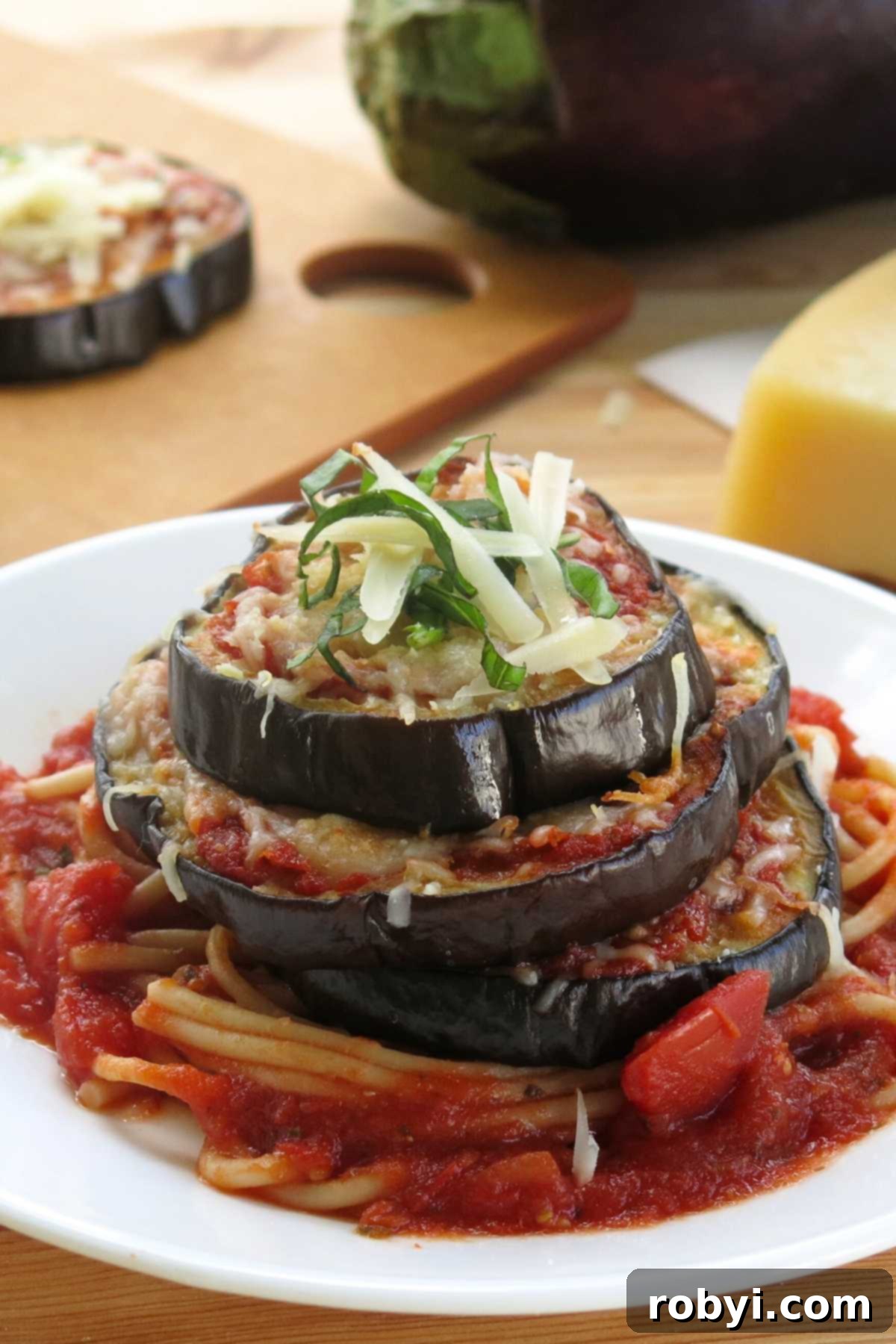
Storing and Reheating Your Eggplant Parmesan Stacks
Proper storage and reheating ensure your delicious leftovers taste just as good as the first serving. Here’s what you need to know:
- Refrigerator: Leftover eggplant parmesan stacks can be stored in an airtight container in the refrigerator for 2-3 days. Make sure they are completely cooled before transferring them to the container to prevent condensation, which can make them soggy.
- Freezer: While traditional eggplant parmesan casseroles often freeze well due to their full coverage of sauce and cheese, we generally do not recommend freezing these no-breading stacks. Because the eggplant slices are less encased in sauce and cheese, the texture of the eggplant can change significantly upon thawing and reheating, becoming softer and potentially mushier. For the best culinary experience, enjoy these stacks fresh or within a few days from the refrigerator.
- Reheat: To reheat your eggplant parmesan stacks, preheat your oven to 350°F (175°C). Place the stacks on a baking sheet and warm them in the oven for about 10-15 minutes, or until heated through and the cheese is bubbly again. For an even fresher taste, you can add a little extra pasta sauce and a sprinkle of fresh mozzarella and Parmesan cheese before reheating. This helps to rehydrate the dish and brings back that lovely melty cheese layer. Avoid reheating in the microwave if possible, as it can often lead to a rubbery texture for the eggplant.
Looking for more family-friendly, low-carb recipes to add to your repertoire?
Explore our extensive collection of Keto-Friendly South Beach Diet Recipes for healthy and delicious meal ideas!
Discover More Italian-Inspired Vegetarian Delights
- Crock-Pot Baked Ziti with Three Cheeses – A comforting and easy one-pot pasta dish.
- Pasta with Olive Oil, Garlic and Mushrooms – A simple yet incredibly flavorful pasta featuring earthy mushrooms.
- Healthy Crock-Pot Vegetarian Lasagna – Enjoy layers of vegetables and cheese in this healthy, slow-cooked lasagna.
Would you like more easy, healthy, carb-conscious recipes delivered right to your inbox?
📋 Recipe: No-Breading Eggplant Parmesan Stacks
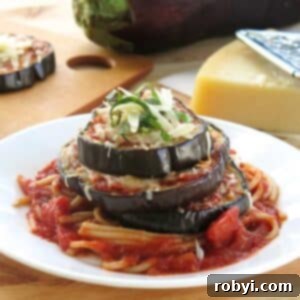
Eggplant Parmesan Stacks (No Breading)
Eggplant Parmesan Stacks are a fantastic low-carb, gluten-free, and easy-to-make alternative to the traditional dish. These delightful oven-baked towers, free from breadcrumbs, will quickly become a cherished family favorite. Made with just 5 simple ingredients, it’s an Italian-inspired vegetarian recipe you’ll love preparing and eating!
Prep Time: 10 minutes
Cook Time: 40 minutes
Total Time: 50 minutes
Servings: 4 servings
Author: Marjory Pilley
Ingredients
- 2 medium eggplants (smaller eggplants work best; remove skins for larger eggplants)
- 2 Tablespoons olive oil
- Salt, to taste
- 1 cup pasta sauce (low-sugar marinara recommended for keto)
- 1 cup mozzarella cheese, shredded
- ½ cup Parmesan cheese, grated (use vegetarian Parmesan if desired)
- ¼ cup Fresh basil, cut into strips for garnish (optional)
Instructions
- Preheat oven to 400°F (200°C).
- Cut eggplant into slices approximately ⅜ of an inch thick. Blot excess moisture from slices with a paper towel.
- Lay slices on a baking sheet coated with cooking spray or lined with parchment paper. Brush the top side with olive oil and sprinkle with salt. Roast for about 12 minutes.
- Remove the pan from the oven, flip the slices over, brush the newly exposed side with olive oil, and sprinkle with salt. Return the pan to the oven and roast for about 12 more minutes.
- Remove the baking sheet from the oven and turn the temperature down to 350°F (175°C).
- Spread a layer of pasta sauce, followed by a sprinkling of mozzarella and Parmesan cheese, on each eggplant slice.
- Return the pan to the oven and bake for 15-20 minutes more, or until the cheeses are melted and bubbly and begin to brown.
- Allow slices to cool for a few minutes before stacking.
- Build a tower by stacking 3 eggplant slices on top of each other, starting with the largest slice on the bottom.
- Garnish with basil and more Parmesan cheese, if desired. Serve warm.
Last Step: We would love for you to leave a rating and comment! Letting us know how you liked this recipe helps our business to thrive so we can continue to provide more free recipes!
Notes
See more expert tips and pictures above for additional guidance.
Storage and Reheating
- Refrigerator: Store leftover eggplant parmesan stacks in an airtight container in the refrigerator for 2-3 days.
- Freezer: While traditional eggplant parmesan casserole freezes well, we do not recommend freezing these stacks. Eggplant is not completely covered with cheeses in this recipe and will have a different, less desirable texture upon thawing and reheating.
- Reheat: Warm leftovers in the oven at 350°F (175°C) for about 10-15 minutes, or until heated through. For best results, add additional sauce and cheese first.
Grab 5 Low-Carb Sauces and get more easy, healthy recipes! JOIN HERE
Nutrition
Carbohydrates: 17g |
Protein: 14g |
Fat: 15g |
Saturated Fat: 5g |
Cholesterol: 26mg |
Sodium: 700mg |
Potassium: 762mg |
Fiber: 7g |
Sugar: 11g |
Vitamin A: 630IU |
Vitamin C: 9.6mg |
Calcium: 400mg |
Iron: 1.4mg
Nutritional and Food Safety Disclaimer
This recipe was originally posted on January 14, 2014, and has been comprehensively updated to enhance the reader experience, incorporate modern dietary considerations, and provide more detailed cooking guidance.
